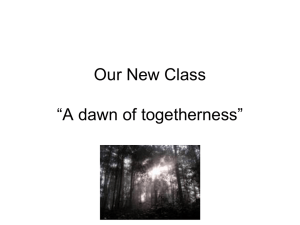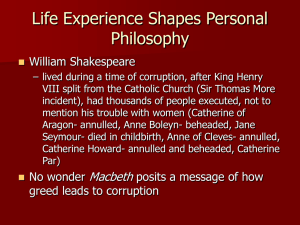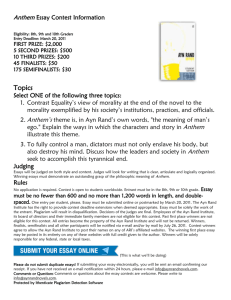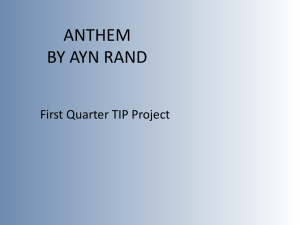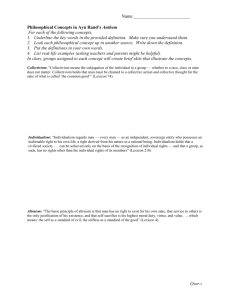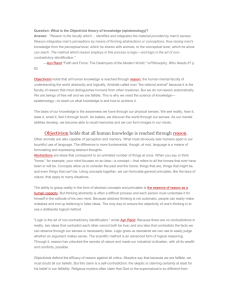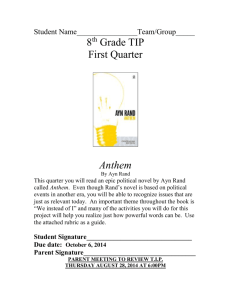Teachers Guide to Anthem
advertisement
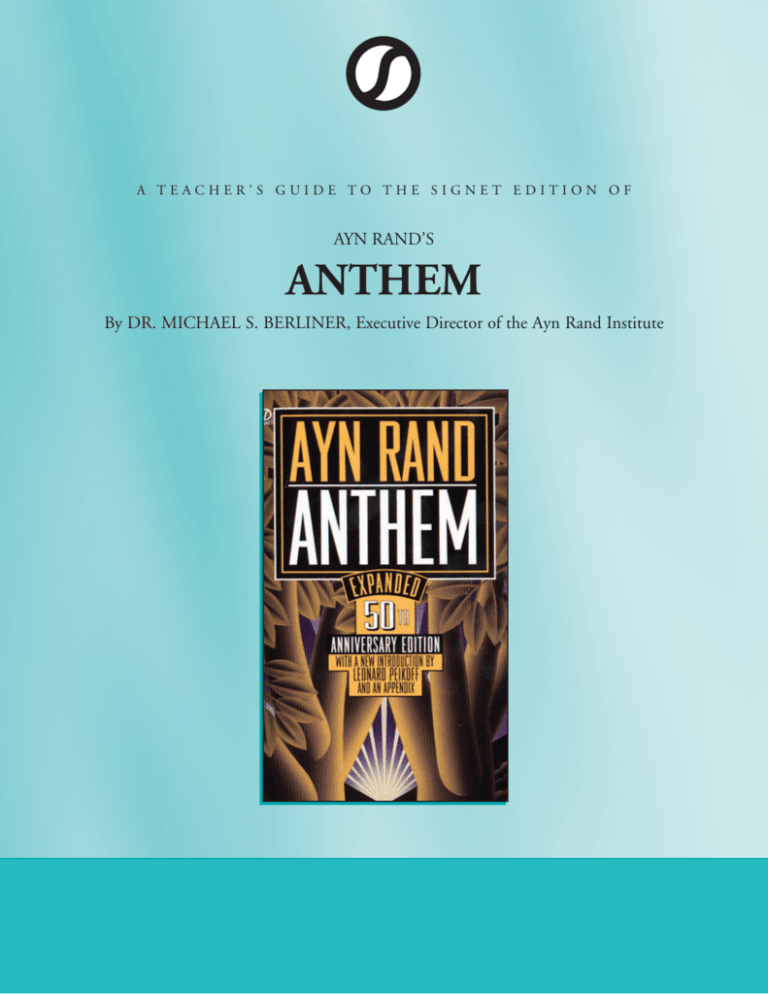
s A TEACHER’S GUIDE TO THE SIGNET EDITION OF AYN RAND’S ANTHEM By DR. MICHAEL S. BERLINER, Executive Director of the Ayn Rand Institute A Teacher’s Guide to Ayn Rand’s Anthem 2 INTRODUCTION Ayn Rand (1905–1982) was born in Russia and educated under the Communists, experiencing firsthand the horrors of totalitarianism. She escaped from Russia in 1926 and came to America because it represented her individualist philosophy. Anthem, written in 1937, is Ayn Rand’s novelette about the essence of collectivism. It was published in England in 1938, went into a limited American edition in 1946, and was then published by New American Library in 1961. The Anthem teacher’s guide has been prepared by Dr. Michael S. Berliner. Dr. Berliner taught philosophy and philosophy of education at California State University, Northridge, where he served as Chairman of the Department of Social and Philosophical Foundations of Education. He regularly used Anthem in his introductory courses to illustrate the meaning of independence. He received his Ph.D. in philosophy from Boston University and is currently executive director of the Ayn Rand Institute. “It is a sin to write this. It is a sin to think words no others think and to put them down upon paper no others are to see.... There is no transgression blacker than to do or think alone.” So begins Anthem, whose theme is, in Ayn Rand’s words, “The meaning of man’s ego.” Anthem projects a completely collectivized society, a society in which the word “I” no longer exists. Anthem is not just a story about the individual being swallowed by the collective. It is also an identification of how that can happen, what ideas people must first accept before such a totalitarian society can take hold. And Anthem is not merely a story about the horrible, depressing life of people in a collectivist society; it is also about the triumph of the individual’s independent spirit, the triumph of those who reject the ethics of collectivism. THE VALUE OF ANTHEM FOR YOUNG STUDENTS Anthem contains many elements that appeal strongly to young readers. It is an exciting and inspiring story, with heroic characters risking their lives for their ideals. It has mystery, carrying students into a science-fiction world of the future. It portrays events with grand significance, challenging readers to decide not just what will happen to particular characters, but what the world should be like. Anthem raises ethical and political issues at a time in the lives of young people when such issues are beginning to take on critical importance: Who am I? Is it possible to stand on my own? The book asks basic question about society: If we could choose what kind of society to have, what should we choose? What is the moral and just society? Does my life belong to the group? Do I have the right to pursue my own happiness? Can a society without freedom be productive? Anthem serves as an introduction to what Ayn Rand called her Romantic Realist approach to literature. Her fiction is Romantic because she portrays “not the random trivia of the day,” not the folks-next-door, but “the timeless, fundamental, universal problems and values of human existence.” Romanticism contrasts with Naturalism, which holds that people are crushed by social forces and cannot control their own destiny. Ayn Rand’s fiction is Realist because she deals with real problems of normal people (not monsters, superhumans or robots). Anthem carries the same heroic view of the individual as her later novels, The Fountainhead and Atlas Shrugged. Anthem also provides an introduction to the ideas she was later to develop into a full, systematic philosophy, which she called “Objectivism.” OVERVIEW When the story begins, sometime in the distant future, the hero (known only as Equality 7-2521) is a young man in his late teens or early twenties. Speaking in the first person plural (Anthem is his diary), he describes his society and his attitude towards it. The society is controlled by the World Council, which directs every aspect of every individual’s life. Each citizen’s life has been controlled from birth: he is conceived in the Palace of Mating. Instead of living with his parents, he first lives in the Home of Infants. As he grows older, he moves to the Home of Students, then to a special home for those of his assigned vocation, and, finally, at old age, to the Home of the Useless. Citizens are constantly barraged with propaganda from the leaders, who preach the glory of working for one’s brothers and the duty of fulfilling “the needs of society.” The alternative is death: “If you are not needed by your brother men,” proclaim the Teachers, “there is no reason for you to burden the earth with your bodies.” It is clear that the citizens have accepted the morality of altruism, which advocates sacrifice to others. As a consequence, the leaders do not rule by physical force or even by the threat of force: they don’t need to. The citizens have no personal desires—they have either given them up voluntarily or never formed them. Citizens obey the leaders without question. Those who have any doubts about their society feel guilty that they do. A Teacher’s Guide to Ayn Rand’s Anthem 3 As Equality 7-2521 begins to describe his life, it becomes clear that the society he lives in has no industry or technology. There are no factories, no machines, almost nothing at all that is man-made. His days are filled with drudgery and routine. Although capable of great intellectual achievement, he has been assigned the job of Street Sweeper. This assignment was not the result of bureaucratic incompetence; on the contrary, the leaders recognized his ability and considered it to be a threat. But he has come upon the remains of a subway entrance from the Unmentionable Times, many years in the past, when there was a prosperous industrial society. Even to think of these times has been forbidden. His individuality still alive, he defies the rules and returns again and again to the subway and to the fascinating technological remains from the past. Down in the subway, he works on abandoned wires and equipment, and he eventually rediscovers electricity and reinvents electric light. He presents his light bulb to the Council of Scholars, believing that they will welcome such a labor-saving, time-saving, life-saving device. However, the Council is frightened by his invention and by his daring to come up with something on his own: “What is not thought by all men,” they cry, “cannot be true.... What is not done collectively cannot be good.” When the Council threatens to destroy the light bulb, he admits to himself that his society is evil. Fleeing with his invention, he escapes to the Uncharted Forest. He knows that the leaders are afraid to venture into the unknown, either intellectually or physically. There he is joined by a young girl with whom he had earlier fallen in love, despite the ban on personal love and friendships. Now named “Prometheus” and “Gaea,” they find a well-preserved house from the Unmentionable Times. In the house is a library of books from those times, and they thus discover the ideas that made possible the freedom and prosperity of the past: man is a separate individual, with a self that is the source of creativity; it is wrong to live for others; conformity, obedience and sacrifice are the cause of human unhappiness and destruction. It is, he now knows, “my eyes which see,” “my mind which thinks,” “my will which chooses.... Neither am I the means to any end others may wish to accomplish. I am not a tool for their use. I am not a servant of their needs. I am not a bandage for their wounds. I am not a sacrifice on their altars.” In these books, he has discovered the word he has been struggling to identify: the word “I.” WHILE READING THE NOVEL UTOPIAS AND ANTI-UTOPIAS This type of fiction is often called “anti-utopian,” meaning that the world presented is the world as it should not be. Other well-known anti-utopian novels, such as 1984 and Brave New World, present collectivism as the worst-possible society. In those books, the society is tyrannical yet has a highly technological economy—a combination that Ayn Rand did not believe possible. She held that economic progress depends upon freedom, that the uncoerced mind is the source of technology, prosperity and progress. Thus the collectivist society she depicts is stagnant and primitive. PHILOSOPHIC MEANING Philosophic issues arise throughout the story, but they are dramatized in action—in the hero’s struggle against his society; they do not appear as philosophic speeches. In this union of ideas and dramatic action, Ayn Rand was unique: she was a philosopher, who wrote nonfiction works on a wide range of philosophic issues; but she was also a novelist, who wrote exciting stories with profound philosophic content. In her novels, she dramatized her philosophy, making those issues alive, concrete and real, showing readers how that philosophy applies to the events of men’s lives. INDIVIDUALISM VS. COLLECTIVISM The principal political issue in Anthem—and in society at large—is the issue of individualism vs. collectivism. The society depicted in Anthem is a collectivist society. “Collectivism,” Ayn Rand wrote, “means the subjugation of the individual to the group—whether to a race, class or state does not matter.” In such a society, the individual is owned by the group; he has no right to a private existence, which means no right to lead his own life, pursue his own happiness or use his own property. The individual exists only as part of the group, and his worth is determined by his service to the group. The alternative to collectivism is individualism, the view advocated by Ayn Rand. “Individualism,” she wrote, “regards man—every man—as an independent, sovereign entity who possesses an inalienable right to his own life, a right derived from his nature as a rational being.” Individualism does not mean that one can do whatever he feels like doing; it means that every man is an individual and has the same rights. “An individualist is a man who says: ‘I will not run anyone’s life— A Teacher’s Guide to Ayn Rand’s Anthem 4 nor let anyone run mine. I will not rule or be ruled. I will not be a master nor a slave. I will not sacrifice myself to anyone—nor sacrifice anyone to myself.’” SELFLESSNESS Anthem dramatizes Ayn Rand’s view that the self is destroyed in a collectivist society. How is the lack of self—or selflessness—shown? No one has a personal name, for, under collectivism, individuals are interchangeable. To prefer one person to another (as a friend or romantic partner) is to commit the cardinal sin: the Transgression of Preference. As in Nazi or Communist societies, it is wrong to disagree, to have independent thoughts, even to ask questions, because to do those things sets one apart from others. Self-assertion is forbidden. All decisions are made by the Council in the name of the whole. Individuals have no rights. No individual choice is allowed by the government: “everything which is not permitted by law is forbidden.” Anthem depicts what happens to a society that implements selflessness. The result, according to Ayn Rand, is a subhuman society: what makes human beings human is having a self, which means having a mind. A selfless individual is a mindless individual. To practice selflessness, one must abstain from thinking and obey one’s masters. To practice collectivism, one must merge himself into the group, and the only way to do this is to obliterate individual identity and individual thought. The result is the kind of society found in Anthem, a society of mindless robots, people with no motivation, no ambition, no hope. They are unable to create anything, and the society they live in has no room for creativity. EGOISM If lacking an ego means that one has become a robot, what, for Ayn Rand, is the exact meaning of egoism? Egoism means “concern with one’s own interests.” It means that oneself, rather than others, is the proper beneficiary of one’s action. Equality 7-2521 is egoistic. He lives for his own happiness; he does’t sacrifice himself to others, nor does he sacrifice others to himself. The egoism he manifests is exactly what the leaders try to eradicate: ambition, wanting things for oneself, wanting to learn, wanting a career that makes him happy, loving someone, thinking for himself. Equality 7-2521 represents the unconquerable human spirit, the affirmation of life. In contrast, almost all of his fellow citizens are gray, passive, non-entities; as such, they are the living dead. Chapter 11 ends with “This one god, this one word: ‘I,’” and the final words of the book refer to the “sacred word: EGO.” Does this mean that egoism is a religion, with the worship of God replaced by the worship of self? No. Ayn Rand has said that she chose the title Anthem “because this is my hymn to man’s ego.” For Ayn Rand, the self is like a god, but is not a god in the religious sense. The ego or self is a “god” in that it is one’s highest value, the source of what is good in life on Earth. FREE WILL One of the oldest and most important philosophic issues is the problem of free will vs. determinism. Those like Ayn Rand, who advocate free will, contend that people can make choices, can make up their own mind, can make decisions, can direct their own lives by the ideas and values they adopt. Those who advocate determinism contend that people are by nature in the grip of forces beyond their control, that their beliefs and values are the result of some force such as God, other people, the stars, economic conditions, instincts or one’s racial heritage. Anthem shows what it means to have free will, and it does so in a particularly interesting way. It depicts a world where people’s lives seem to be determined but it’s actually a world where people have free will. Students often believe that in Anthem only the heroic characters have free will, that the masses are indeed brainwashed, with no power to control their own lives. However, as Ayn Rand presents them, even those who submit to the authorities have free will. They are robots, but they are robots by choice: they were not forced to obey; they do so because they voluntarily abdicated the responsibility to think for themselves. They are depressed, without hope or ambition; they make no effort to accomplish anything; they merely obey and go along with orders. Ayn Rand holds that free will means “the choice to think or not.” Most of the citizens have chosen not to think, which leaves them no alternative but to do whatever they’re told to do. How is free will manifested in Anthem? Prometheus relies on his own judgment rather than take the beliefs of his leaders as automatically true. His rediscovery of electricity is the prime example of free will: he himself initiates the thinking required to understanding the world around him; this is what makes him independent. Neither he nor his friends are bound by tradition. That the past is “unmentionable” does not prevent them from mentioning it; that the forest beyond their city is “uncharted” does not prevent them from reaching it. And this is the ultimate meaning of a free-will approach to life: the future is open to man; what you attain is up to you; your values and your ultimate happiness are achievable. In Ayn Rand’s view, man has the power to think and direct his life; he isn’t doomed to a life of despair and defeat. If he is willing to rely on himself rather than be pushed by events, he can, like the heroic characters in Anthem achieve self-confidence. A Teacher’s Guide to Ayn Rand’s Anthem 5 AFTER READING THE NOVEL SUGGESTED STUDY QUESTIONS AND ACTIVITIES 1. Why did Ayn Rand name her main characters “Prometheus” and “Gaea”? Look these names up in a book on mythology. Compare the myths about Prometheus and Gaea to the story of these two characters. 2. In her Foreword to Anthem, Ayn Rand summarizes her political views. What laws that we have today do you think she would agree with, and which would she oppose? 3. What might it be like to live in a society where there are no “selves” and “we” has replaced “I”? In your classroom, construct the “ideal society” as envisioned by the Council of Scholars. 4. Prometheus’s intellectual activities are illegal in his society. Throughout history, many great innovators, such as Copernicus, Galileo, Watt, and Fulton have faced ridicule and even legal attacks. Research the struggle faced by one of these individuals. Write a dialogue between that person and Prometheus. How would Prometheus try to encourage that person? 5. Why did Prometheus try to convince the Council of Scholars that his invention merited their support? If a government council thinks that an invention will not benefit the community, should the invention be banned? Compare the situation in the novel to such government agencies as the Federal Drug Administration and the Federal Aviation Administration, which allow new products or new air routes only if they will “benefit the community.” 6. For Prometheus, life in the Uncharted Forest is quite different from what he has known. Write two brief messages that Prometheus might want to send to any two characters who are still in the city. 7. Read about a “positive” utopia, such as in Plato’s Republic or Thomas More’s Utopia, and compare with Anthem. 8. Read about a “negative” utopia, such as in George Orwell’s 1984 or Aldous Huxley’s Brave New World. Write a letter to Ayn Rand comparing the world of the future in one of those books to the world of the future in Anthem. 9. Compare the expulsion of Adam and Eve from the garden of Eden to the story of Prometheus and Gaea. For what “sins” were each condemned? 10. Which nations do you think are the most like the society in Anthem ? Which are the least like it? 11. What is “collectivism”? Which of our laws today are collectivist? 12. Is the world of Anthem more like the United States of 1776 or the United States today? 13. Compare the idea of equality as used in the Declaration of Independence to the idea of equality as practiced in Anthem. 14. The absence of industrial technology and other man-made inventions characterized the society of Anthem. Compare this to the society aimed at by environmentalism. 15. Ayn Rand held that freedom is a prerequisite for economic progress. Is this view confirmed by the histories of the U.S.S.R. and the People’s Republic of China? EXTENDING LEARNING AN OBJECTIVIST BIBLIOGRAPHY AYN RAND’S NOVELS We the Living (1936): Set in Soviet Russia, this is Ayn Rand’s first and most autobiographical novel. Its theme is: “the individual against the state, the supreme value of a human life and the evil of the totalitarian state that claims the right to sacrifice it.” Anthem (1938): This novelette depicts a world of the future, a society so collectivized that even the word “I” has vanished from the language. Anthem ‘s theme is: the meaning and glory of man’s ego. A Teacher’s Guide to Ayn Rand’s Anthem 6 The Fountainhead (1943): The story of an innovator—architect Howard Roark—and his battle against a traditionworshipping society. Its theme: “individualism versus collectivism, not in politics, but in man’s soul; the psychological motivations and the basic premises that produce the character of an individualist or a collectivist.” Ayn Rand presented here for the first time her projection of the ideal man. Atlas Shrugged (1957): Ayn Rand’s complete philosophy, dramatized in the form of a mystery story “not about the murder of a man’s body, but about the murder—and rebirth—of man’s spirit.” The story is set in a near-future U.S.A. whose economy is collapsing due to the inexplicable disappearance of the country’s leading innovators and industrialists—the “Atlases” on whom the world rests. The theme is: “the role of the mind in man’s existence—and, as corollary, the demonstration of a new moral philosophy: the morality of rational self-interest.” AYN RAND’S OTHER FICTION Night of January 16th (1934): A courtroom play in which the verdict depends on the sense-of-life of jurors selected from the audience. The Early Ayn Rand (1984): A collection of stories and plays written by Ayn Rand in the 1920s and 1930s, plus passages cut from The Fountainhead. AYN RAND’S NONFICTION For the New Intellectual (1961): A collection of the key philosophical passages from her novels. The 48-page title essay sweeps over the history of thought, showing how ideas control the course of history and how philosophy has served for the most part as an engine of destruction. The Virtue of Selfishness (1964): Ayn Rand’s revolutionary concept of egoism. Essays on the morality of rational selfishness and the political and social implications of such a moral philosophy. Essays include: “The Objectivist Ethics,” “Man’s Rights,” “The Nature of Government,” and “Racism.” Capitalism: The Unknown Ideal (1966): Essays on the theory and history of capitalism demonstrating that it is the only moral economic system, i.e., the only one consistent with individual rights and a free society. Includes: “What is Capitalism?” “The Roots of War,” “Conservatism: An Obituary,” and “The Anatomy of Compromise.” Introduction to Objectivist Epistemology (1967): The Objectivist theory of concepts, with Ayn Rand’s solution to “the problem of universals,” identifying the relationship of abstractions to concretes. Includes an essay by Leonard Peikoff, “The Analytic-Synthetic Dichotomy.” The second edition (1990) includes transcripts of Ayn Rand’s workshops on her theory—containing her answers to questions about her theory raised by philosophers and other academics. The Romantic Manifesto (1969): Ayn Rand’s philosophy of art, with a new analysis of the Romantic school of literature. Essays include: “Philosophy and Sense of Life,” “The Psycho-Epistemology of Art,” and “What is Romanticism?” The New Left: The Anti-Industrial Revolution (1971): Ayn Rand’s answer to environmentalism, “progressive” education, and other contemporary anti-reason movements. Philosophy: Who Needs It (1982): Everybody needs philosophy—that is the theme of this book. It demonstrates that philosophy is essential in each person’s life, and shows how those who do not think philosophically are the helpless victims of ideas they accept passively from others. Essays include “Philosophical Detection,” “Causality Versus Duty,” and “The Metaphysical Versus the Man-Made.” The Ayn Rand Lexicon: Objectivism from A to Z (1986): A mini-encyclopedia of Objectivism, containing the key passages from the writings of Ayn Rand and her associates on 400 topics in philosophy and related fields. Edited by Harry Binswanger. The Voice of Reason: Essays in Objectivist Thought (1989): Philosophy and cultural analysis, including “Who Is the Final Authority in Ethics?” Also “Religion Versus America” by Leonard Peikoff, and “Libertarianism: The Perversion of Liberty” by Peter Schwartz. The Ayn Rand Column (1991): A collection of Ayn Rand’s columns for the Los Angeles Times, and other essays. Ayn Rand’s Marginalia (1995): Notes Ayn Rand made in the margins of the works of more than twenty authors, including Barry Goldwater, C.S. Lewis, and Ludwig von Mises. Edited by Robert Mayhew. Letters of Ayn Rand (1995): This collection of more than 500 letters offers much new information on Ayn Rand’s life as philosopher, novelist, political activist, and Hollywood screenwriter. Edited by Michael S. Berliner. A Teacher’s Guide to Ayn Rand’s Anthem 7 Journals of Ayn Rand (1997): An extensive collection of Ayn Rand’s thoughts—spanning forty years—on literature and philosophy, including notes on her major novels and on the development of the political philosophy of individualism. Edited by David Harriman. WORKS BY LEONARD PEIKOFF Leonard Peikoff, Ayn Rand’s legal and intellectual heir, is the pre-eminent authority on Objectivism. The Ominous Parallels: The End of Freedom in America (1982): The Objectivist philosophy of history—through an analysis of the philosophical causes of Nazism, and their parallels in contemporary America. Objectivism: The Philosophy of Ayn Rand (1991): This is the definitive, systematic statement of Ayn Rand’s philosophy, based on Dr. Peikoff ’s thirty years of philosophical discussions with her. All of the key principles of Objectivism—from metaphysics to art—are presented in a logical, hierarchical structure. Visit the Ayn Rand Institute’s website: www.aynrand.org E S S AY C O N T E S T S Essay contests on both The Fountainhead (for 11th and 12th graders) and Anthem (for 9th and 10th graders) are sponsored annually by the Ayn Rand Institute. 47 prizes in all are awarded, with the top prize a cash award of $5,000. For complete details, write the Ayn Rand Institute at PO Box 6004, Inglewood, CA 90312 ABOUT THE AUTHOR OF THIS GUIDE This teacher’s guide has been prepared by DR. MICHAEL S. BERLINER. Dr. Berliner taught philosophy and philosophy of education at California State University, Northridge, where he served as Chairman of the Department of Social and Philosophical Foundations of Education. He regularly used Anthem in his introductory courses to illustrate the meaning of independence. He received his Ph.D. in philosophy from Boston University and is currently Executive Director of the Ayn Rand Institute. FREE TEACHER’S GUIDES A full list of Teacher’s Guides and Teacher’s Guides for the Signet Classic Shakespeare Series is available on Penguin’s website at: www.penguin.com/academic TEACHER’S GUIDES Animal Farm • Anthem • Beloved • Beowulf • The Call of the Wild • Cannery Row • City of God • The Country of the Pointed Firs and Other Stories • The Crucible • Death of a Salesman • Dr. Jekyll and Mr. Hyde • Dubliners • Ethan Frome • The Fountainhead • Girl in Hyacinth Blue • The Grapes of Wrath • A Journey to the Center of the Earth • The Jungle • The Life of Ivan Denisovich • Looking Backward • Lysistrata • Main Street • Of Mice and Men • The Mousetrap and Other Plays • A Narrative of the Life of Frederick Douglass, An American Slave • Nectar in a Sieve • 1984 • The Odyssey • The Passion of Artemisia • The Pearl • Persuasion • The Prince and the Pauper • A Raisin in the Sun • The Red Pony • Redwall • The Scarlet Letter • The Scarlet Pimpernel • Silas Marner • A Tale of Two Cities • The Time Machine • Up from Slavery • The Women of Brewster Place • Wuthering Heights TEACHER’S GUIDES FOR THE SIGNET CLASSIC SHAKESPEARE SERIES Antony and Cleopatra • As You Like It • Hamlet • Henry V • Julius Caesar • King Lear • Macbeth • Measure for Measure • A Midsummer Night’s Dream • Much Ado About Nothing • Othello • Richard III • Romeo and Juliet • The Taming of the Shrew • The Tempest • Twelfth Night Visit the Penguin Group (USA) web site at www.penguin.com to browse all Signet Classic paperback editions and www.penguin.com/scessay for information about the Annual Signet Classic Scholarship Essay Contest
